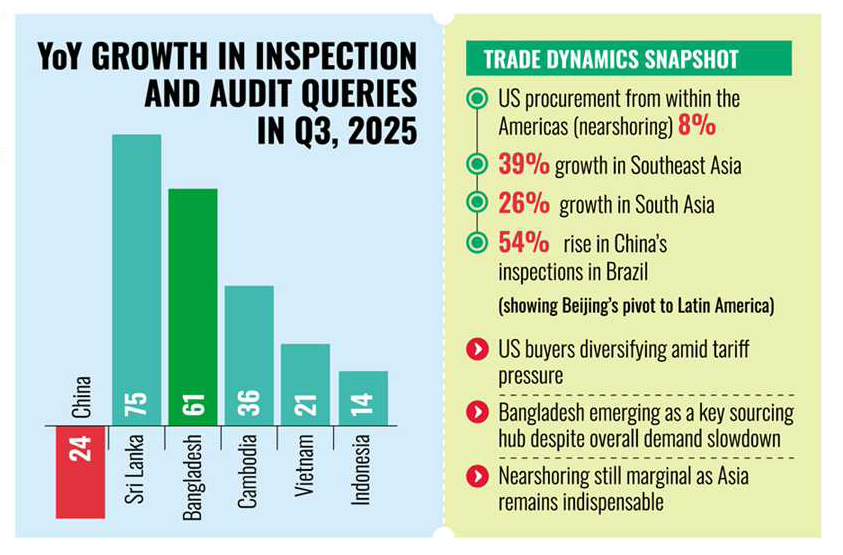Bangladesh witnesses sharp rise in US buyer audits amid shift from China
Queries jump 61% YoY as importers diversify sourcing across South, Southeast Asia

Published :
Updated :

Bangladesh has emerged as one of the strongest performers among Asian sourcing destinations, recording a 61 per cent year-on-year rise in inspection and audit queries from US buyers in the third quarter of 2025.
The surge reflects American companies' continued shift away from China amid trade tensions and punitive tariffs.
According to the latest QIMA Barometer, published on October 14, overall US overseas procurement slowed during August and September, but Bangladesh and several neighbouring countries maintained steady growth in compliance inspections, underscoring Asia's central role in the United States' evolving sourcing landscape.
The report by Quality Inspection Management (QIMA), a leading provider of supply chain compliance solutions, attributes the rise to the ongoing realignment of US global sourcing, which is opening new opportunities for manufacturing hubs across South and Southeast Asia.
Nearly six months after the US introduced its 'Liberation Day' policy shift, the Q4 2025 QIMA Barometer found that inspection and audit activity by US buyers remained subdued in both August and September after peaking in July.
The barometer, titled "Despite US Tariff Posturing, World Favors Trade Over Wars," revealed that inspection and audit volumes in China fell by 24 per cent year-on-year in the third quarter of 2025, reflecting the combined effects of tariffs and deliberate efforts by US companies to de-risk their supply chains.
"Throughout the quarter, other Asian sourcing hubs worked to fill the gap. Southeast Asia and South Asia saw inspection activity rise by 39 per cent and 26 per cent YoY, respectively, with double-digit growth in demand recorded in Vietnam, Cambodia, Indonesia, Bangladesh, and Sri Lanka," the report noted.
Within the region, Sri Lanka recorded the highest growth, with inspection and audit demand soaring 75 per cent year-on-year, driven by renewed apparel orders as buyers diversified away from both China and India.
Cambodia, Vietnam, and Indonesia followed with growth rates of 36 per cent, 21 per cent, and 14 per cent, respectively.
Despite these positive trends, QIMA warned that the outlook for US sourcing in Asia remains uncertain.
The introduction of new "transshipment tariffs," aimed at curbing indirect exports from China through third countries, could disrupt trade with key Southeast Asian hubs such as Vietnam.
The report also noted that growing trade tensions with India in late August have already started to appear in sourcing data, raising doubts about whether the current pace of diversification can be sustained.
Meanwhile, America's much-publicised push for nearshoring and reshoring has shown limited progress.
QIMA data indicated that only 8.0 per cent of total US procurement in the third quarter of 2025 originated from within its own region, underscoring the continued structural dependence of American retailers and manufacturers on Asian suppliers.
While US demand weakened, China strengthened its trade links with emerging markets, particularly in Latin and South America.
Inspections and audits for Chinese textiles, electronics and homeware suppliers rose significantly in Brazil (up 54 per cent year-on-year), Uruguay (69 per cent), and Argentina (16 per cent), the report said.
European buyers, by contrast, maintained a steadier approach to sourcing.
Inspection demand across Southeast Asia has increased by 8.0 per cent year-on-year, led by Vietnam (21 per cent), Thailand (18 per cent), and Cambodia (10 per cent).
Closer to home, nearshoring partnerships around the Mediterranean posted solid gains in the third quarter of 2025, with inspection activity rising by 15 per cent in Morocco, 19 per cent in Tunisia, and 24 per cent in Egypt.
Egypt's strong performance, according to the report, reflected its growing role as a regional rival to Turkey, supported by significant foreign investment in its textile industry.
When asked about the QIMA findings, Bangladesh Garment Manufacturers and Exporters Association (BGMEA) Senior Vice-President Inamul Haq Khan said Vietnam and Cambodia, which cater to the higher-end segments of the apparel market, are performing particularly well.
"As US consumers reduced their purchases, work orders slowed during the last quarter (July-September), but we hope the flow will pick up again in the final quarter of 2025," he added.
He also noted that Bangladeshi exporters face increasing competition in the European market, as both India and China are aggressively seeking to expand their business there following the imposition of high US tariffs on their exports.
Munni_fe@yahoo.com


 For all latest news, follow The Financial Express Google News channel.
For all latest news, follow The Financial Express Google News channel.